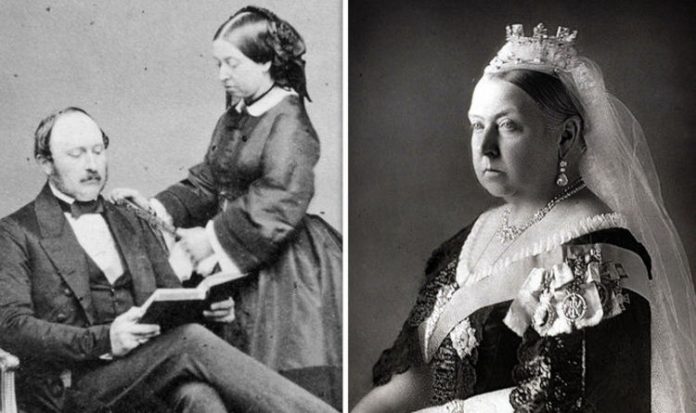Albert and Victoria’s love story has been well-documented over the centuries, especially as the famous Queen ended up spending half of her life in mourning for her husband. Her reign was longer than any of her predecessors’ and has only been topped by current Queen Elizabeth II. Yet, when Albert died in 1861, Victoria’s time on the throne became overshadowed by her grief and she dressed in widow’s black until her own death in 1901.
Her husband was initially thought to have died from typhoid fever, but experts have disputed over the cause of his death in recent decades.
In the weeks leading up to his demise, he is believed to have told his wife: “I do not cling to life. You do; but I set no store by it.
“If I knew that those I love were well cared for, I should be quite ready to die tomorrow … I am sure if I had a severe illness, I should give up at once.
“I should not struggle for life. I have no tenacity for life.”

Prince Albert and Queen Victoria (Image: Getty)

Victoria and Albert had a large family with nine children (Image: Getty)
During their 17 years of marriage, the couple had nine children — four boys and five girls — and established the image of domestic bliss.
However, there was more to their relationship than meets the eye.
Albert would often take over Victoria’s regal duties when she fell pregnant, leaving the Queen to feel nothing short of resentment for being stripped of her powers.
Additionally, she felt repeatedly falling pregnant meant she was “more like a rabbit or a guinea pig than anything else and not very nice”.
Writing in 2013, the BBC explained: “There were terrible rows and Albert was terrified by Victoria’s temper tantrums.
READ MORE: Royal mystery unravelled in huge row over Prince Albert’s autopsy

Victoria was heavily dependent on Albert and distraught when he died (Image: Getty)
During their 17 years of marriage, the couple had nine children — four boys and five girls — and established the image of domestic bliss.
However, there was more to their relationship than meets the eye.
Albert would often take over Victoria’s regal duties when she fell pregnant, leaving the Queen to feel nothing short of resentment for being stripped of her powers.
Additionally, she felt repeatedly falling pregnant meant she was “more like a rabbit or a guinea pig than anything else and not very nice”.
Writing in 2013, the BBC explained: “There were terrible rows and Albert was terrified by Victoria’s temper tantrums.
DON’T MISS
Prince Albert fury: Monaco’s strict rule for citizens [INSIGHT]
Royals unmasked: Grace Kelly’s stunning impact on Monaco laid bare [EXPLAINED]
Queen heartbreak: Prince Philip ‘poised to cause monarch grief’ [EXPOSED]

Albert made a shocking confession about his life to his wife shortly before his death (Image: Getty)

Victoria remained in mourning clothes for the rest of her life — pictured with her great-grandchildren in 1900 (Image: Getty)
Still, Bertie apologised when his father came to visit him and they went for a walk in the rain to talk it through.
But when Albert returned to Windsor Castle, he fell ill and never recovered — leading the Queen to blame her son for her heartbreak.
She once wrote: “I never can or shall look at him without a shudder.”
However, Albert had suffered from bouts of ill health from childhood.
Additionally, Victoria was determined to make their home together freezing, never heating a room above 68 degrees, which may have exacerbated his rheumatism.

Edward VII — known as Bertie — was blamed by his mother for his father’s death (Image: Getty)
Albert also complained that the “weak stomach with which [he] came into the world”, he would “take with him to his grave”.
He even admitted in 1851 he felt “more dead than alive from overwork” — a decade before he died.
According to History Extra’s website, “illness always lowered Albert’s spirits and brought on a heightened sense of fatalism”.
He continued to push himself even when his health fell into decline in the last two years of his life.
Albert reportedly said: “I know that I dare not stop for a moment to relax. Like the hawk, I must not sleep, but be forever on the watch.”
His death in 1861 heralded in a new era for the monarchy as Victoria became the “widow of Windsor”, a grief-stricken figure whose shadowy appearance even stoked a wave of republicanism.







